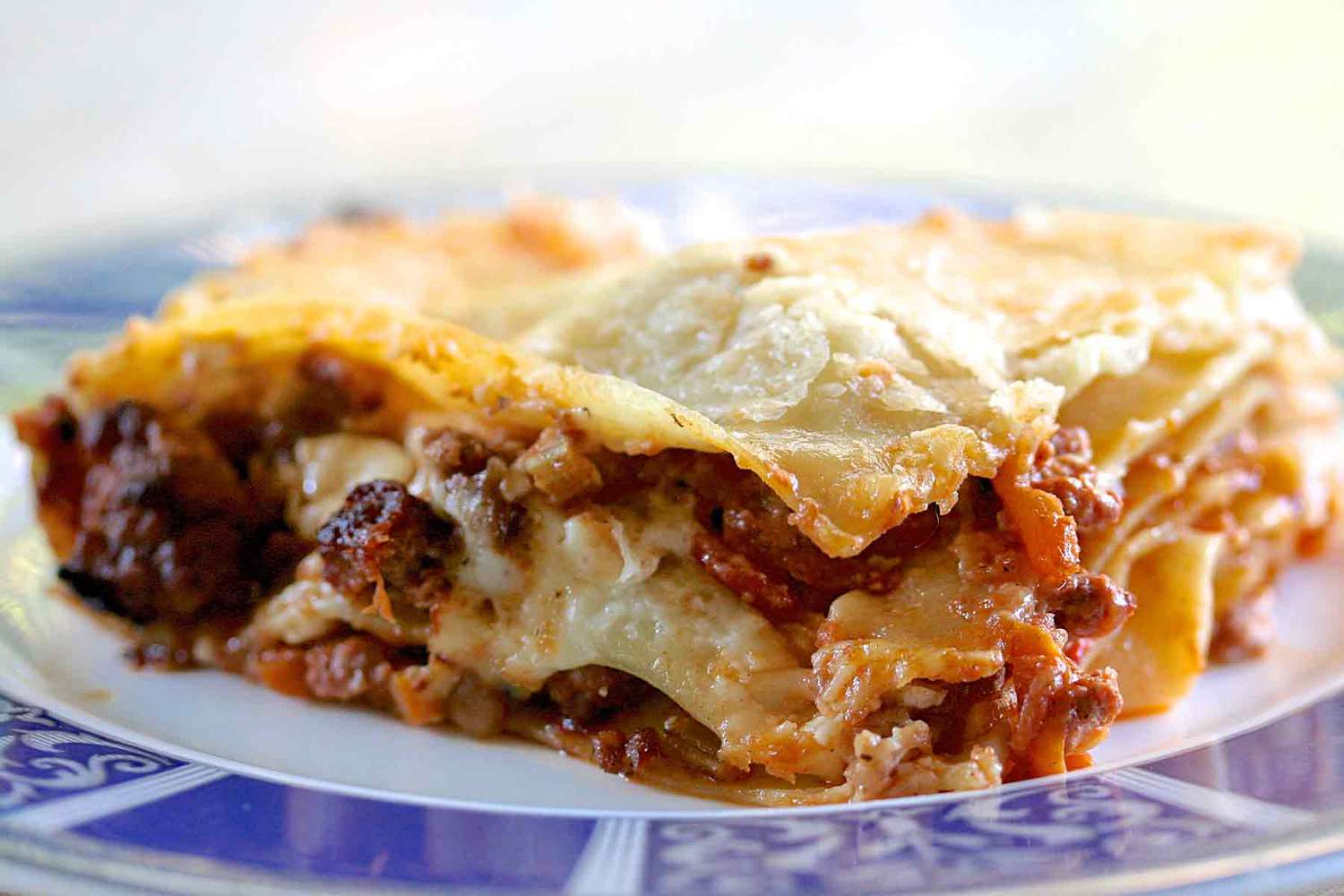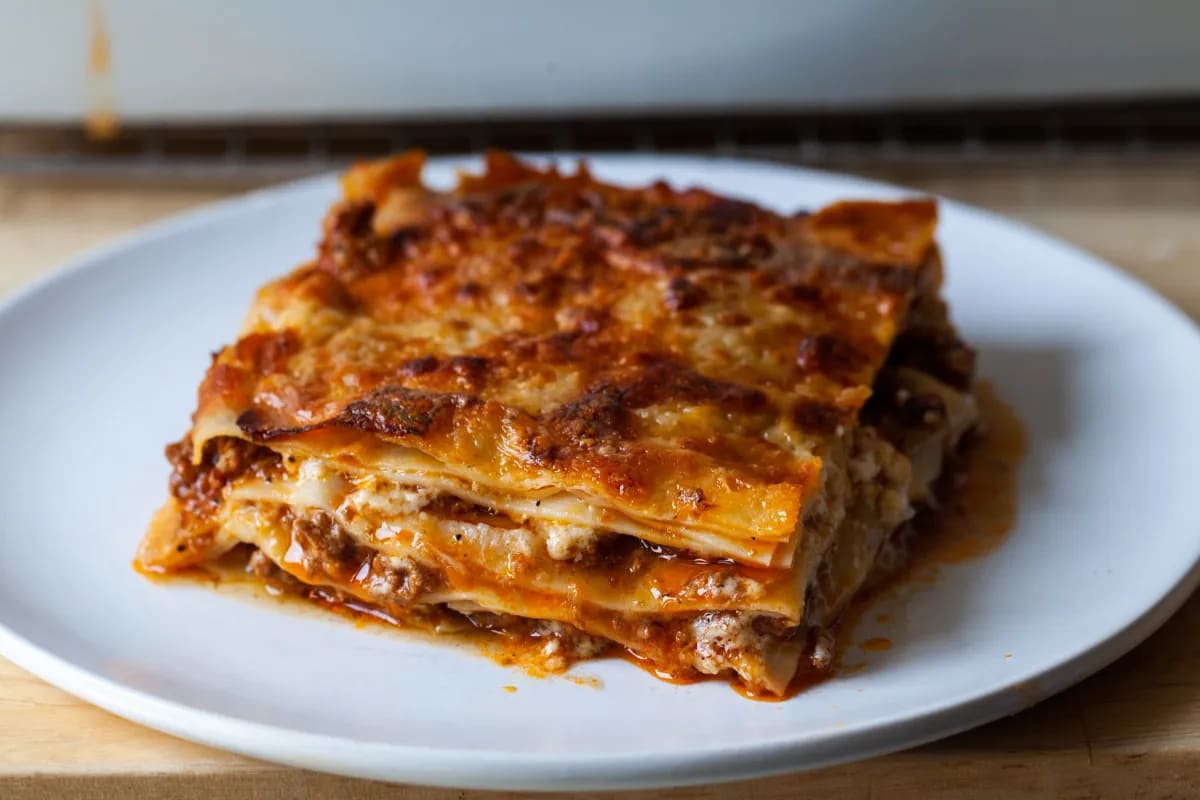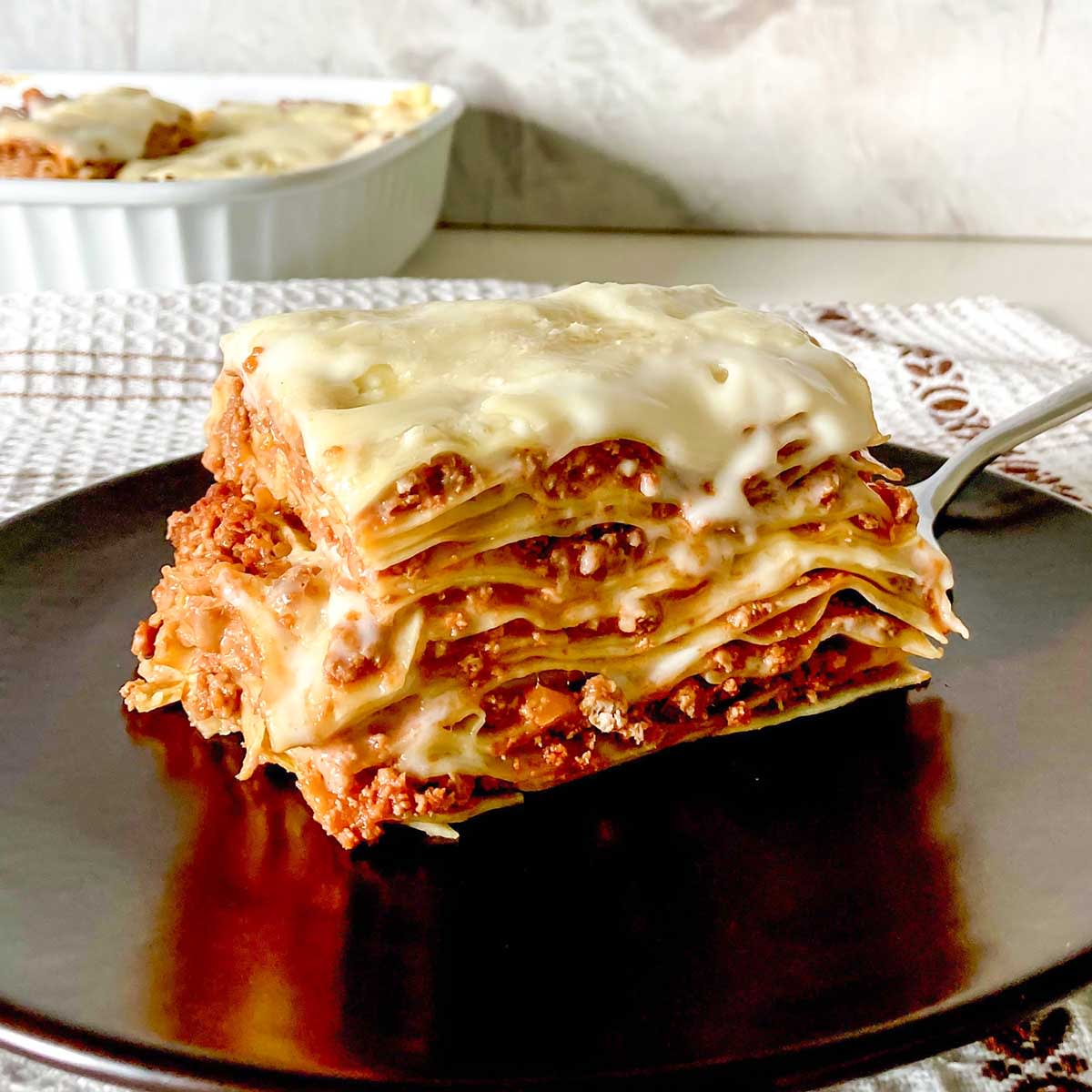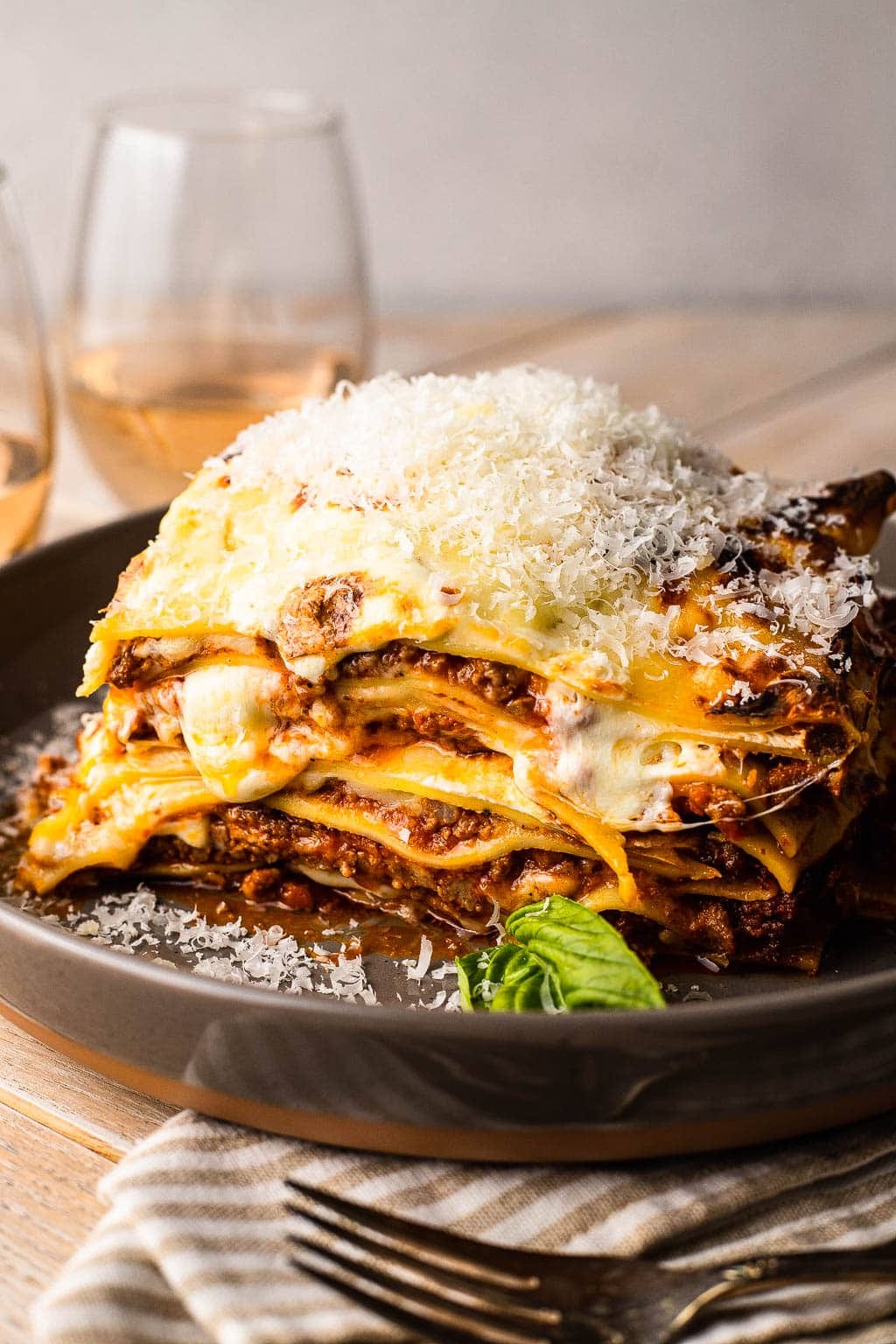Lasagna Bolognese
This Lasagna Bolognese isn’t your quick weeknight casserole – it’s a slow-simmered masterpiece that transforms humble ingredients into something truly extraordinary. The rich, complex Bolognese sauce develops incredible depth during its long simmer, while the silky béchamel adds a luxurious creaminess that puts this miles above any lasagna you’ve had before.

What makes this recipe special is the authentic approach – combining three different meats, aromatic vegetables, and unexpected warming spices like cinnamon and clove. Then there’s the game-changing addition of milk to the meat sauce, a traditional technique that creates unbelievable tenderness and richness. Trust me, once you experience the velvety layers of pasta, meat sauce, and béchamel melding together, you’ll understand why this dish deserves its legendary status.

Ingredients

For the Bolognese Sauce:
- 2 ounces diced pancetta, finely chopped
- 1 medium Spanish onion or yellow onion, finely chopped
- 1 rib celery, finely chopped
- 1 carrot, finely chopped
- 4 tablespoons unsalted butter
- 11 ounces ground beef
- 4 ounces ground pork
- 4 ounces ground Italian sausage
- 1 clove, freshly ground
- Dash freshly ground cinnamon
- 1 teaspoon freshly ground black pepper
- 2 pounds tomatoes, peeled and chopped, or 1 (28-ounce) can whole peeled tomatoes
- 1 cup whole milk
- 1/2 teaspoon sea salt
For the Béchamel Sauce:
- 2 cups whole milk
- 1/4 cup unsalted butter
- 1/4 cup all-purpose flour
For the Lasagna:
- 16 sheets lasagna noodles (De Cecco brand recommended)
- 1 cup freshly grated Parmesan cheese

Steps

Prepare the Bolognese Meat Sauce
- Make the soffritto: Combine pancetta, onion, celery, and carrot in a large sauté pan with butter and cook over medium heat for 8-10 minutes until the onion turns pale gold. This aromatic base is crucial for building flavor, so don’t rush this step – the vegetables should soften but not brown.
- Add the meats: Add the beef, pork, and sausage to the soffritto and increase the heat to high. Break the meat apart with a wooden spoon and cook for 5-7 minutes until thoroughly browned. The meat should lose its raw appearance completely and develop some caramelized edges for maximum flavor.
- Add the spices: Sprinkle with the ground clove, cinnamon, and pepper, stirring to distribute evenly. These warming spices are the secret to authentic Bolognese depth – they’ll seem subtle but make a huge difference in the final flavor.
- Add the tomatoes: Stir in the tomatoes and bring to a simmer. Reduce the heat to medium and cook for 15 minutes, stirring occasionally. If using whole canned tomatoes, break them up with your spoon as they cook. The tomatoes should begin to break down and integrate with the meat mixture.
- Add milk and simmer: Pour in the milk, season with sea salt, then reduce heat to low and let simmer for 2 and 1/2 hours. Stir at least every 20 minutes to prevent sticking. Whenever the sauce reduces to the point that it’s sticking to the bottom of the pan, add 1/4 cup water and scrape up the browned bits. The long simmer is non-negotiable – this is where the magic happens as flavors meld and deepen.
Make the Béchamel Sauce
- Heat the milk: In a heavy-bottomed saucepan, heat the milk until almost boiling (about 180°F/82°C). You’ll see small bubbles forming around the edges, but don’t let it come to a full boil.
- Make the roux: In a separate pan, melt the unsalted butter with the flour over low heat. Stir rapidly with a spoon in a figure-eight motion to prevent lumps. Cook for exactly 1 minute to cook out the raw flour taste without browning, then remove from heat.
- Add half the milk: Very slowly add half the hot milk to your butter-flour mixture, whisking constantly. Pour in a thin stream while whisking vigorously to prevent lumps from forming. If lumps do form, whisk energetically until they dissolve.
- Add remaining milk and thicken: Return the mixture to low heat until it begins to thicken (about 3-5 minutes). Add the remaining milk slowly while stirring, incorporating it into the thickened sauce. Continue stirring until it comes to a gentle boil. The sauce should coat the back of a spoon but still be pourable.
- Season and finish: Season with a pinch of sea salt (about 1/4 teaspoon), and continue stirring until it reaches a smooth, velvety consistency that’s thick enough to coat the back of a spoon. If any lumps form, beat them out rapidly with a whisk. Remove from heat immediately to prevent over-thickening.
Prepare the Lasagna
- Preheat oven to 375°F (190°C) and position rack in the middle of the oven.
- Cook the lasagna noodles: Bring 6 quarts of water to a rolling boil in a large pot. Add 2 tablespoons salt and cook the lasagna according to package instructions, about 8 minutes for al dente. They should be slightly firm as they’ll continue cooking in the oven. Drain and rinse with cold water to stop the cooking process.
- Prepare noodles for assembly: Lay the individual lasagna noodles out on clean kitchen towels, making sure they don’t touch each other to prevent sticking. This step is crucial for easy assembly later.
- Prepare baking dish: Spread a thin layer of olive oil (about 1 tablespoon) around the inside of a 13×9-inch baking pan. Use a non-reactive pan (pyrex or stainless steel) as aluminum will react with the acidic sauce and create a metallic taste.
- Layer the lasagna: Start with a layer of noodles on the bottom, slightly overlapping them. Spread 1/3 of the bolognese sauce (about 2 cups) evenly over the noodles, then pour 1/3 of the béchamel (about 3/4 cup) over the meat sauce. Sprinkle with 1/4 cup grated Parmesan. Repeat these layers two more times.
- Add final layer: Top with a final layer of noodles and sprinkle with the remaining Parmesan cheese (about 1/4 cup). This creates a golden, crispy top layer.
- Bake: Tent the casserole loosely with aluminum foil to prevent over-browning. Place in the preheated oven and bake for 20-30 minutes, until the top begins to get lightly browned and the edges are bubbling. The internal temperature should reach 165°F (74°C) for food safety.
- Rest before serving: Remove from oven and let cool for 5-10 minutes before serving. This resting period is essential – it allows the layers to set and makes for cleaner slices when serving.

Smart Swaps
- Replace the ground meats with 1 pound finely chopped mushrooms plus 1/2 cup cooked lentils for a vegetarian version
- Use gluten-free lasagna noodles (cook for 2 minutes less than package directions to prevent mushiness)
- Substitute 2 tablespoons olive oil for butter in the béchamel for a lighter sauce
Make It Diabetes-Friendly
- Use whole wheat lasagna noodles to reduce the glycemic impact (reduces carbs by approximately 8g per serving)
- Replace half the ground meat with 1 cup finely chopped mushrooms to reduce calories while maintaining texture
- For the béchamel, use unsweetened almond milk instead of whole milk (reduces carbs by 6g per serving)
- Portion into 8 equal servings (approximately 3×3 inches each) and pair with a large green salad to reduce overall glycemic load
Pro Tips
- The Bolognese sauce can be made up to 3 days ahead and refrigerated, which actually improves the flavor
- For perfectly clean slices, refrigerate the baked lasagna for 3 hours before reheating individual portions
- When layering, use the back of a ladle to gently spread the sauces without disturbing the pasta layers
- For an authentic finish, drizzle each serving with a small amount of high-quality extra virgin olive oil